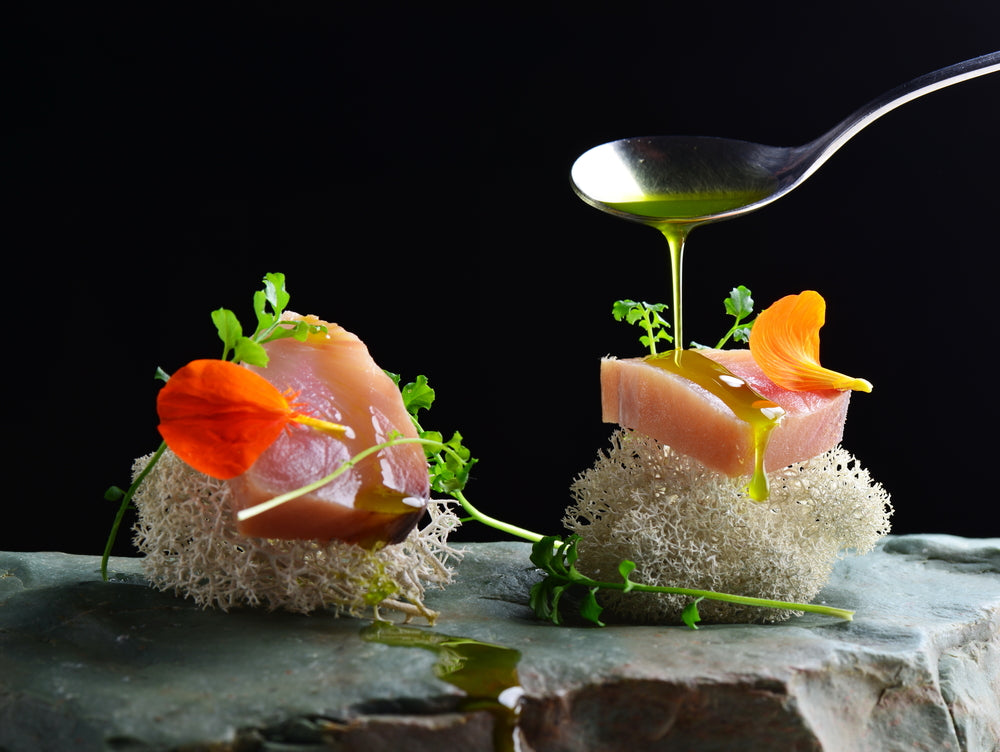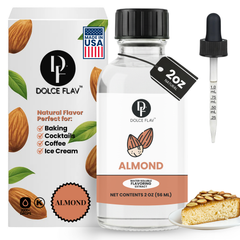
When you think of fine dining, you obviously think of the highest quality foods made from scratch, presented in a manner that is elevated beyond that of any normal dining experience, and of course, the venue and staff that highlight the quality of the food with an impeccable atmosphere.
However, while all those things are pivotal to the fine dining experience, chefs have a few tricks up their sleeves that help them create unique dishes that stun your tastebuds when you come to their restaurants.
One of those is that food flavoring, or flavoring extracts, is quite popular, and it tends to have a huge impact on guests and the experience offered by the establishment.
Today, we want to go over the role of food flavoring in fine dining, how it enhances the guest experience, and how it’s commonly used.
Let’s get started.
What is Food Flavoring?
Food flavoring is a unique product that has come a long way in recent years. You’ve probably used certain traditional food flavorings already, such as peppermint extract or vanilla extract, but now, there’s a whole world of flavorings to explore.
In simplest terms, food flavoring is the essence of a certain flavor extracted and mixed with a carrier oil.
For example, mint flavoring is just the extracted flavor molecules of mint leaves added to an edible, food-grade, flavor-neutral oil.
However, food scientists have taken this simple concept and turned it into an art.
Rather than simply extracting existing flavors from common items and infusing them in oils, they’re making wild flavors from scratch.
With a little chemistry and patience, new food flavorings and extracts are made all the time to make everything from cheesecake to pistachio flavorings that are essentially all the flavor of those items in liquid form.
Obviously, you can’t just pulverize a cheesecake and infuse it in oil. So, these extracts are made from carefully chosen ingredients that more or less trick your tastebuds into thinking you’re eating whatever wild food has been represented by the extract.
Why are Food Flavorings Essential for Fine Dining Experiences?
With a fine dining experience, most people expect the entire focus to be around using the finest ingredients to their maximum potential, and that’s definitely the core foundation of it, but it’s always the goal of a chef in such an environment to elevate food to the next level. It’s more than just a classic dish with innovative alterations or perfect techniques put into cooking it. It’s supposed to transcend what the guest expects from the dish and innovate our understanding of culinary possibilities.
That’s where food flavoring comes in. Since almost anything can be replicated as a food flavoring, and food flavoring can be added to almost anything, it creates endless possibilities.
At one point, making a mousse taste exactly like a birthday cake or fresh peaches would have seemed like the crazed ramblings of someone who didn’t belong in a kitchen. Now, it’s not only possible but also easy.

That’s not to say that food flavorings take the skill out of creating dishes worthy of fine dining experiences. The chef certainly needs to know how and when to use them. However, when it is appropriate, just adding a drop or two of oil-based flavoring completely changes the dish.
How Do Flavorings Impact the Guest?
The guest is the first priority of any staff member in a fine dining establishment. Not only are they directly responsible for the bills getting paid and keeping the place open, but the entire point of fine dining is to impress guests with experiences no one else can provide.
So, how do food flavorings come into play when it comes to the guest’s experience?
Here are a few examples.
1: Unique Culinary Opportunities
As we’ve stated before, the possibilities are endless when food flavorings are used. They’re extremely flexible, and they allow for unique culinary treats that would have never been possible before.
This means that, given the chef has a bit of creative flair and is capable of using flavorings effectively, guests can experience truly unique dishes that wouldn’t otherwise be possible, and they certainly won’t find them elsewhere.
For example, we’re aware that this is an atrocious suggestion, but something like birthday cake-flavored spaghetti isn’t something you’d find on any menu. While a horrendous idea, it’s possible with food flavorings. Similar, yet far better combinations, are possible, as well.
2: Subtle Notes of Flavors
Guests expect to truly sit down and savor their food at a fine dining experience. They want to pick apart the flavors and try to explore every bit of flavor and texture that a dish has to offer. It’s a crucial part of the fine dining experience.
This has been achieved traditionally by carefully balancing ingredients, but food flavorings allow for an extra layer. When used sparingly and in the right context, food flavoring can create a subtle note that adds to the experience and rounds off a dish.
For example, think about a cream-based alcoholic beverage that is heavily flavored with chocolate and mint. Those are strong flavors and can cover up any subtle notes, but a concentrated extract flavored like strawberries can cut through that and add just a little hint of the iconic strawberry flavor on the end.

We're not fine-dining chefs. So, these are just examples of how food flavorings can be used, but the amount of utility you get out of a little vial of flavoring is immense.
3: Preserve Texture While Adding Flavor
Sometimes, the best flavor profile can be ruined by the texture of a dish. For example, think of a creamy dessert drink meant to taste like a cupcake. If you were to just break up a cupcake or even blend it, you’d completely change the texture of the drink, and it would probably be overly thick or ruined thanks to cakey chunks.
However, by using a cupcake flavoring, you can achieve the same effect without changing the texture at all. You only use a few drops of flavoring in a dish, and in terms of texture, it’s just oil. It disappears into the dish entirely.
Since texture is a huge part of enjoying a dish, this can have a massive impact on the guest’s experience in a multitude of situations.
4: A Healthier Experience
Fine dining is rarely about eating healthy. It’s difficult to label butter-rich lobster tails, extravagant pasta with rich sauces, and decadent desserts as healthy options. However, some dishes do aim to provide at least lower calorie options to guests, and guests do seek those out. Especially if they’re lucky enough to enjoy fine dining experiences semi-regularly.
We’re not calling food flavorings “healthy”, as you would lean meats and vegetables, but there is definitely a difference between eating a whole cheesecake and eating a cheesecake-flavored mousse.
Food flavorings can be used to pack a relatively low-calorie option with flavor that otherwise wouldn’t be possible without tons of sugar, fat, and similar ingredients.
5: Enjoying Lighter Courses
Guests at fine dining establishments often sit through several courses to experience a wide variety of dishes in one meal. This is an amazing experience, but it can be difficult to balance each dish in a way that is satisfying without leaving the guest feeling engorged by the third course with several more to go.
This somewhat aligns with the health aspect we mentioned earlier, but the goal is more to create flavorful dishes that aren’t as filling during multi-course meals.
This is extremely helpful with ingredients that tend to be so rich they’re filling even if you limit how much is plated. Namely, cakes, sweets, and similar items.
If you’re able to use a flavoring as an alternative to a particularly rich ingredient, the guest can experience that flavor without wanting to check out of the meal early. After all, the flavor comes from just a few drops of oil when you use a food flavoring.
What Types of Dishes are Food Flavorings Used for?
The role of food flavoring in fine dining is substantial, as food flavorings can be used for practically any type of dish. You can make strawberry-cream fried chicken with food flavorings if you really want to.
Obviously, they work better for some dishes than others, and finding the best uses for them is what’s truly going to enhance the guest’s experience.
Here are some of the main types of dishes that food flavorings are used for.
1: Alcohol
Cocktails are prime uses for food flavorings. Especially when you’re talking about the sweeter options and fruit-based flavors like mango.

This gives the guest a great-tasting alcoholic beverage that doesn’t require a bunch of floating ingredients and other things that make the experience a hassle.
2: Desserts
Since most food flavorings tend to be fruity or based on existing decadent desserts, they’re commonly used to flavor high-end desserts in restaurants.
For example, let’s say you want to give your guests a raspberry-flavored frosting on top of a unique cake you baked, but you need the frosting to be creamy, rich, and free of any rough textures that would come from actually using raspberries.
A food flavoring would help you achieve that.
3: Colorless Drinks and Foods
The presence of colorless gelatin or a water-like drink can completely throw a guest for a loop. A big part of food is presentation, and when the food is transparent, it creates a visual disconnect that can drive a powerful message or simply stir a reaction.
However, it’s not enough to just make something look out of the ordinary. It still needs to taste great.
Food flavorings are colorless oils, essentially. They might have a tint, but it’s so light and so little is used that whatever you’re adding them to won’t be affected visually.
This is used regularly to make flavorful dishes that detach from plating standards and create foreign and unique visual appeal during a dining experience.
4: Sauces
This is another area where food flavorings shine. Guests don’t just expect sauces. They’re necessary for a wide variety of dishes. They add texture, complementary flavors, and moisture when it’s needed.
In this category, it’s usually the fruitier flavors that are utilized.
For example, if a dish needs a sweet and spicy barbeque sauce to match a tender, lean, cut of chicken, a peach flavor extract can provide the sweetness and subtle peachy flavor while the other ingredients take center stage. This adds the flavor, but it doesn’t require extensive prep and blending like adding real peaches would.
The Food Flavorings Must Be of the Highest Quality
For the guest to enjoy any of this, the flavorings used need to be made to the highest quality standards. This is fine dining after all. The same high-quality expectations guests have for the more traditional ingredients are also expected for things such as food flavorings.
There’s a real difference in how the quality of a food flavoring impacts the guests, too.
As we said earlier, food flavorings are essentially a type of food science, and every manufacturer is going to have a different recipe. Even the slightest corner cut, or the smallest difference in ratios, can dramatically change how good a food flavoring is.
Many cheap or mass-produced flavorings are fairly consistent, but they’re not painstakingly tested to ensure they taste exactly like the food they’re emulating. A high-quality, fine-dining-worthy food flavoring won’t enter the market unless it’s tested, reworked, tested again, and so on and so forth to make it as good as possible.
Those seemingly insignificant differences do translate into the guest’s experience. Better quality flavorings will more accurately emulate what they’re trying to do, they’ll taste better, and the guest will pick up on the flavor without noticing that it’s a trick with food flavoring rather than the fresh version of the food in question.
Get the Highest Quality Food Flavorings from Dolce Foglia
Now that you understand the role of food flavoring in fine dining, you probably want to experiment with the endless possibilities they provide.
Whether you’re a chef preparing a fine dining menu or a home cook who just wants to try something new, Dolce Foglia has the highest quality oil-soluble flavoring and water-based extracts available in a wide range of flavors. Browse our selection today.

